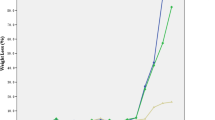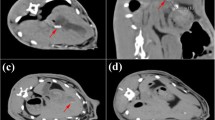Abstract
Aiming at deficiencies in non-degradable stents for benign common bile duct obstruction, the magnesium (Mg)-based braided stents were developed with one monofilament as a pilot research in this paper. We designed stents with the different monofilament diameter, braided-pin number and surface treatment systematically to study the mechanical and degradation behaviors. The results suggest the fluorinated Mg stents and them with polycaprolactone (PCL) coating can achieve the compression force of 3.35–11.07 N and 11.09–24.08 N, and even maintain 3.10–10.43 N for 3 days immersion and 3.11–9.37 N for 20 days immersion respectively. PCL coating on monofilament can provide significantly better compression force and corrosion resistance. By comparison with the stent in clinic, these Mg stents are expected to meet the demand of the radial compression force and implantation time. Furthermore, the degradation occurs at the ends preferentially for all stents, but for stents without PCL coating, the intersections of wire-mesh are also the area easily corroded. Additionally, the result of the compression test indicates the radial compression force is improved with the increase of monofilament diameter and pins number, but the recovery capability decreases slightly.
Graphic abstract









Similar content being viewed by others
Abbreviations
- CBD:
-
Common bile duct
- FDA:
-
Food and Drug Administration
- PCL:
-
Polycaprolactone
- F c :
-
Radial compression force
- E recovery :
-
Elastic recovery ratio
References
Xu XY, Liu TJ, Liu SH, Zhang K, Shen Z, Li YX, Jing XB (2009) Feasibility of biodegradable PLGA common bile duct stents: an in vitro and in vivo study. J Mater Sci Mater Med 20:1167–1173. https://doi.org/10.1007/s10856-008-3672-2
Daldoul S, Moussi A, Zaouche A (2012) T-tube drainage of the common bile duct choleperitoneum: etiology and management. J Visc Surg 149:e172–e178. https://doi.org/10.1016/j.jviscsurg.2012.03.008
van Boeckel PG, Vleggaar FP, Siersema PD (2009) Plastic or metal stents for benign extrahepatic biliary strictures: a systematic review. BMC Gastroenterol 9:96. https://doi.org/10.1186/1471-230X-9-96
Elwir S, Sharzehi K, Veith J, Moyer MT, Dye C, McGarrity T, Mathew A (2013) Biliary stenting in patients with malignant biliary obstruction: comparison of double layer, plastic and metal stents. Dig Dis Sci 58:2088–2092. https://doi.org/10.1007/s10620-013-2607-z
Luigiano C, Ferrara F, Cennamo V, Fabbri C, Bassi M, Ghersi S et al (2012) A comparison of uncovered metal stents for the palliation of patients with malignant biliary obstruction: nitinol vs. stainless steel. Dig Liver Dis 44:128–133. https://doi.org/10.1016/j.dld.2011.08.015
Almeida GG, Donato P (2020) Biodegradable versus multiple plastic stent implantation in benign biliary strictures: a systematic review and meta-analysis. Eur J Radiol 125:108899. https://doi.org/10.1016/j.ejrad.2020.108899
Ginsberg G, Cope C, Shah J, Martin T, Carty A, Habecker P et al (2003) In vivo evaluation of a new bioabsorbable self-expanding biliary stent. Gastrointest Endosc 58:777–784. https://doi.org/10.1016/S0016-5107(03)02016-9
Girard E, Chagnon G, Broisat A, Dejean S, Soubies A, Gil H et al (2020) From in vitro evaluation to human postmortem pre-validation of a radiopaque and resorbable internal biliary stent for liver transplantation applications. Acta Biomater 106:70–81. https://doi.org/10.1016/j.actbio.2020.01.043
Mauri G, Michelozzi C, Melchiorre F, Poretti D, Tramarin M, Pedicini V et al (2013) Biodegradable biliary stent implantation in the treatment of benign bilioplastic-refractory biliary strictures: preliminary experience. Eur Radiol 23:3304–3310. https://doi.org/10.1007/s00330-013-2947-2
Zheng YF, Gu XN, Witte F (2014) Biodegradable metals. Mater Sci Eng Res 77:1–34. https://doi.org/10.1016/j.mser.2014.01.001
Liu Y, Zheng SM, Li N, Guo HH, Zheng YF, Peng JR (2017) In vivo response of AZ31 alloy as biliary stents: a 6 months evaluation in rabbits. Sci Rep 7:40184. https://doi.org/10.1038/srep40184
Rebelo R, Vila N, Fangueiro R, Carvalho S, Rana S (2015) Influence of design parameters on the mechanical behavior and porosity of braided fibrous stents. Mater Des 86:237–247. https://doi.org/10.1016/j.matdes.2015.07.051
Chen YG, Yan J, Wang XH, Yu S, Wang ZG, Zhang XN et al (2014) In vivo and in vitro evaluation of effects of Mg–6Zn alloy on apoptosis of common bile duct epithelial cell. Biometals 27:1217–1230. https://doi.org/10.1007/s10534-014-9784-x
Chen YG, Yan J, Wang ZG, Yu S, Wang XH, Yuan ZM et al (2014) In vitro and in vivo corrosion measurements of Mg–6Zn alloys in the bile. J Mater Sci Mater Med 42:116–123. https://doi.org/10.1016/j.msec.2014.05.014
Ding PF, Liu YC, He XH, Liu DB, Chen MF (2019) In vitro and in vivo biocompatibility of Mg–Zn–Ca alloy operative clip. Bioact Mater 4:236–244. https://doi.org/10.1016/j.bioactmat.2019.07.002
Gu XN, Zheng YF, Cheng Y, Zhong SP, Xi TF (2009) In vitro corrosion and biocompatibility of binary magnesium alloys. Biomaterials 30:484–498. https://doi.org/10.1016/j.biomaterials.2008.10.021
Min Y, Debao L, Runfang Z, Minfang C (2018) Microstructure and properties of Mg–3Zn–0.2Ca alloy for biomedical application. Rare Met Mater Eng 47:0093–0098. https://doi.org/10.1016/S1875-5372(18)30078-X
Liu H, Sun C, Wang C, Li YH, Bai J, Xue F et al (2020) Improving toughness of a Mg–Ca-containing Mg–Al–Ca–Mn alloy via refinement and uniform dispersion of Mg2Ca particles. J Mater Sci Technol 59:61–71. https://doi.org/10.1016/j.jmst.2020.02.092
Sun LX, Bai J, Xue F, Tao L, Chu CC, Meng J (2017) Exceptional texture evolution induced by multi-pass cold drawing of magnesium alloy. Mater Des 135:267–274. https://doi.org/10.1016/j.matdes.2017.09.027
Cai H, Zhang Y, Meng J, Li X, Xue F, Chu CL, Tao L, Bai J (2018) Enhanced fully-biodegradable Mg/PLA composite rod: effect of surface modification of Mg–2Zn wire on the interfacial bonding. Surf Coat Technol 350:722–731. https://doi.org/10.1016/j.surfcoat.2018.07.045
Cai H, Meng J, Li X, Xue F, Chu CL, Guo C, Bai J (2019) In vitro degradation behavior of Mg wire/poly(lactic acid) composite rods prepared by hot pressing and hot drawing. Acta Biomater 98:125–141. https://doi.org/10.1016/j.actbio.2019.05.059
Pitt HA, Nakeeb A, Espat NJ (2012) In: Jarnagin WR, Blumgart LH (eds) Blumgart’s surgery of the liver, pancreas and biliary tract, 5th edn. Elsevier, Philadelphia, pp 113–122
Lu J, Wu DH, Rohani S (2014) Influence of Ca2+ on cholesterol crystallization from supersaturated model biles. Fluid Phase Equilib 367:51–56. https://doi.org/10.1016/j.fluid.2014.01.031
William H, Admirand SDM (1968) The physicochemical basis of cholesterol formation in man. J Clin Invest 47:1043–1052. https://doi.org/10.1172/JCI105794
Zhu YQ, Yang K, Cheng RY, Xiang Y, Yuan TW, Cheng YS, Sarment OB, Cui WG (2017) The current status of biodegradable stent to treat benign luminal disease. Mater Today 20:516–529. https://doi.org/10.1016/j.mattod.2017.05.002
Liu YH, Zhang PH (2016) Characterization of compression behaviors of fully covered biodegradable polydioxanone biliary stent for human body: a numerical approach by finite element model. J Mech Behav Biomed 62:128–138. https://doi.org/10.1016/j.jmbbm.2016.04.029
Zou QH, Xue W, Lin J, Fu YJ, Guan GP, Wang FJ, Wang L (2016) Mechanical characteristics of novel polyester/NiTi wires braided composite stent for the medical application. Results Phys 6:440–446. https://doi.org/10.1016/j.rinp.2016.07.007
Nicolas F, Renick DL, Ryo T, Juan LG, Alessio M (2014) Impact of stent strut design in metallic stents and biodegradable scaffolds. Int J Cardiol 177:800–808. https://doi.org/10.1016/j.ijcard.2014.09.143
Sanchez AHM, Luthringer BJC, Feyerabend F, Willumeit R (2015) Mg and Mg alloys: how comparable are in vitro and in vivo corrosion rates? A review. Acta Biomater 13:16–31. https://doi.org/10.1016/j.actbio.2014.11.048
Meng B, Wang J, Zhu N, Meng QY, Cui FZ, Xu YX (2006) Study of biodegradable and self-expandable PLLA helical biliary stent in vivo and in vitro. J Mater Sci Mater Med 17:611–617. https://doi.org/10.1007/s10856-006-9223-9
Zhao SJ, Liu XY, Gu LX (2012) The impact of wire stent fabrication technique on the performance of stent placement. J Med Devices 1:007–011. https://doi.org/10.1115/1.4005788
Yan TT, Tan LL, Xiong DS, Liu XJ, Zhang BC, Yang K (2010) Fluoride treatment and in vitro corrosion behavior of an AZ31B magnesium alloy. Mater Sci Eng C Mater 30:740–748. https://doi.org/10.1016/j.msec.2010.03.007
Preeti M, Jin KH, Andrew RP, Ihho P, Byoung-Gi M, Taek LB (2018) Development and properties of duplex MgF2/PCL coatings on biodegradable magnesium alloy for biomedical applications. PLoS ONE 13:e193927. https://doi.org/10.1371/journal.pone.0193927
Zeng RC, Cui LY, Jiang K, Liu R, Zhao BD, Zheng YF (2016) In vitro corrosion and cytocompatibility of a microarc oxidation coating and poly(l-lactic acid) composite coating on Mg–1Li–1Ca alloy for orthopedic implants. ACS Appl Mater Interfaces 8:10014–10028. https://doi.org/10.1021/acsami.6b00527
Chen LX, Sheng YY, Zhou HY, Li ZB, Wang XJ, Li W (2019) Influence of a MAO + PLGA coating on biocorrosion and stress corrosion cracking behavior of a magnesium alloy in a physiological environment. Corros Sci 148:134–143. https://doi.org/10.1016/j.corsci.2018.12.005
Acknowledgements
This work was supported by the National Key Research and Development Program of China (2016YFC1102402), the National Natural Science Foundation of China (51971062) and the Science and Technology Project of Jiangsu Province (BE2019679).
Author information
Authors and Affiliations
Corresponding author
Additional information
Handling Editor: Annela M. Seddon.
Publisher's Note
Springer Nature remains neutral with regard to jurisdictional claims in published maps and institutional affiliations.
Electronic supplementary material
Below is the link to the electronic supplementary material.
Rights and permissions
About this article
Cite this article
Zhang, Y., Chen, K., Liu, H. et al. A study of a biodegradable braided Mg stent for biliary reconstruction. J Mater Sci 55, 17170–17182 (2020). https://doi.org/10.1007/s10853-020-05289-9
Received:
Accepted:
Published:
Issue Date:
DOI: https://doi.org/10.1007/s10853-020-05289-9




